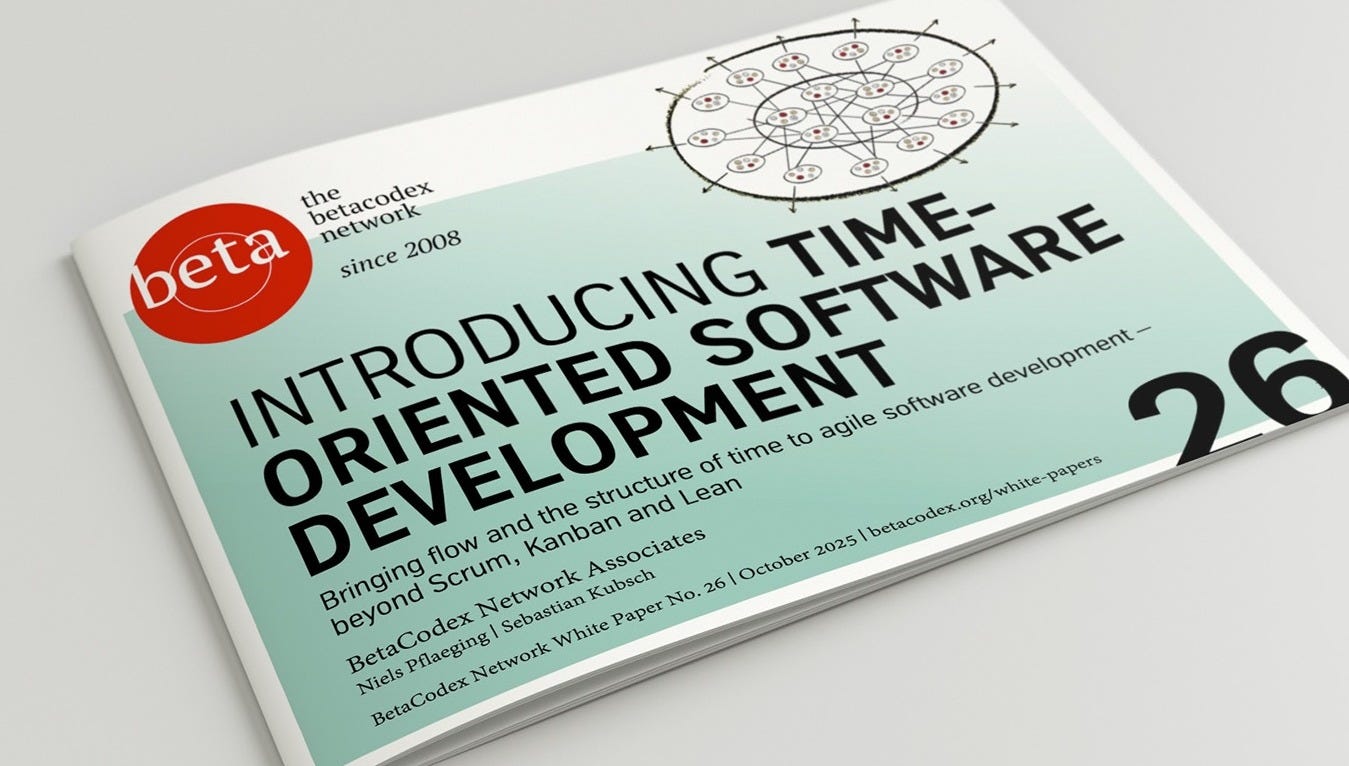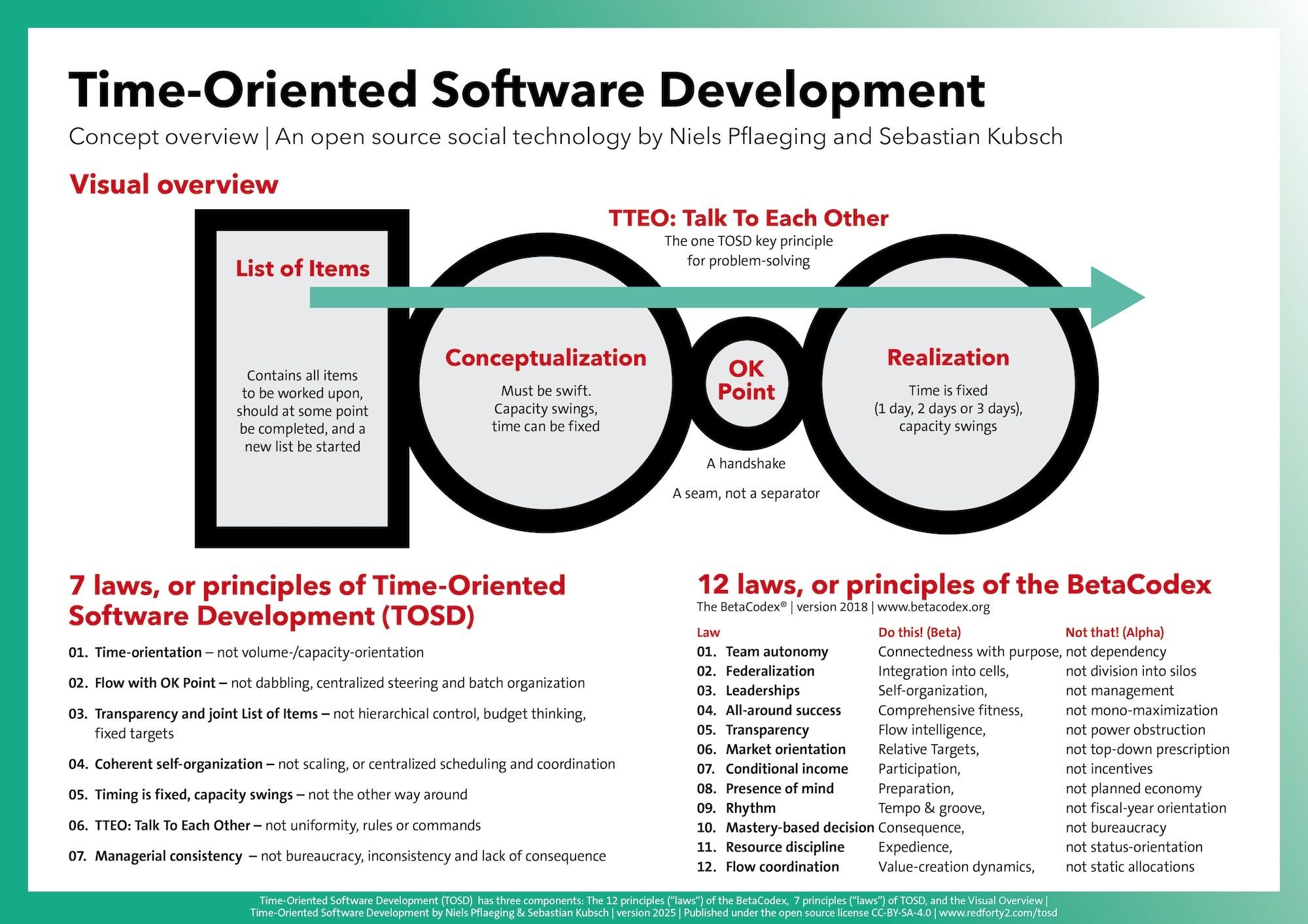Introducing Time-Oriented Software Development: The 26th BetaCodex research paper is here
TOSD arrives at a time of turmoil for the Agile movement. The promise of time-orientation is to bring speed, punctuality, flow and true agility to software development, at last
by Niels Pflaeging
Until recently, Agile was everywhere. After the 2001 manifesto and well into the 2020s, Agile methodologies were spreading fast, becoming de-facto standard approaches for software development and throughout related industries. Of all Agile approaches, Scrum made the biggest splash. According to estimates, at least 3.3 million people worldwide obtained Scrum certifications. At its height, enthusiasts claimed to bring the Scrum revolution to schools and education. It seemed that agility knew no boundaries, spreading to all kinds of industries and professions. During the 2010s, if you were talking about business, or management, and failed to mention Agile at least in passing, people would hardly listen to you. Opportunities for Agile Scaling were endless. In short: It was awesome. And for a brief, beautiful moment, Agile seemed to take over the world.
Take a closer look at the Agile movement and the software development scene now, and the picture looks rather different. Most development teams and software companies have retreated to improvised, “blended” approaches to development that might be qualified as dabbling. Clearly, most Agile scaling projects have stalled or failed. At the end of 2024, Agile Alliance joined the Project Management Institute PMI – or shall we say there was a merger Waterfall Inc.? By late 2025, Agile Coaches have fallen completely out of fashion in some countries. Criticism of Scrum is mounting, reliance on Scrum in companies is fading fast.
While some believe that Agile is dead, or history at least, we are not so sure. According to a German saying, “those declared dead live longer”. Agile may still be up for renewal, a rejuvenation or resurrection. But while a revival is possible, it will likely come at the price of serious reform of Agile conceptually and structurally, including reform of institutions and the related business models. In order for Agile to make a comeback, the movement’s key figures and institutions with a stake in Agile would have to overcome decade-long conceptual stagnation, opening up to insights like time-orientation, in earnest.
Time-orientation opens the door to self-improvement and high performance
Time is the ultimate structure. Few organizations today are fully recognizing this – and even fewer management experts, one might add. The first company in modern history to make great use of the structure of time has been Toyota, of course. Toyota gave us not just lean concepts like kanban and kaizen. It also created or popularized time-oriented language and vocabulary, e.g. just-in-time, takt, heijunka, or flow.
The crucial role of time-orientation as a necessary foundation of self-organization, however, has been best described by Austrian lean pioneer Ernst Weichselbaum, to whom our research paper on Time-Oriented Software Development is dedicated:
“Time orientation is a connector, not a divider. A bridge, not a wall.
Time orientation is a prerequisite for organizational networks and self-organization.”
Ernst Weichselbaum
Ernst Weichselbaum (1944-2024) created his own, consistently time-oriented approach to production and organizational development. First as a manager at Austrian office furniture company Bene, then, starting in the 1990s, as a successful consultant and change advisor. Ernst pioneered a unique insight: That when a system is set up for flow and punctuality, our view of capacity will change, accordingly:
“In time orientation, capacity is not scheduled (a.k.a. ‘flexible’).
Instead, capacity is designed as a system.”
Ernst Weichselbaum
Which ultimately leads to the insight that in time-orientation, where delivery time is fixed (as much as possible) the organization’s capacity will swing. Such insights around time and organizations are still widely ignored today. They are deemed impossible or undesirable by most. With TOSD, however, these insights are now coming to “agile” software development. The groundbreaking and proven concepts developed by time-orientation pioneers like Taiichi Ohno and Ernst Weichselbaum are embedded in Time-Oriented Software Development and spelled out in our new research paper, in detail.
It’s the BetaCodex Network’s 26th research paper. Our 2nd on the timely topic of time-orientation
This is the second research paper on time-orientation at work we are publishing this year. The previous paper on time-orientation, Slave to the Rhythm: Adopt Time-Oriented Work Systems. Now, is well worth reading, too, if you want to understand the concepts of time-orientation more profoundly, and if you intend to apply these concepts beyond software development.
We,
and I, hope that you will enjoy reading the Introducing Time-Oriented Software Development paper. Let us know what it makes you think of.More about Time-Oriented Software Development (TOSD)
Read the brand new BetaCodex Network research paper No. 26, Introducing Time-Oriented Software Development, by
and . PDF download is free of charge and free of registration!Learn more about the TOSD team, about support for TOSD adopters and upcoming events, by visiting the TOSD web page at timeoriented.dev.
Check out the TOSD open source license: Time-Oriented Software Development is free to use (even commercially) under the CC-BY-SA license from Creative Commons
Read an interview with TOSD co-creator Sebastian Kubsch on the Red42 Substack
Read an intro article to the story of TOSD on this Substack
Buy the print version of the TOSD research paper, and get the TOSD concept overview poster for yourself, your team, your organization
Learn about the 1st Bochum Conference on Time-Oriented Software Development on 26 February 2026 (in German). Conference tickets are on sale already!




